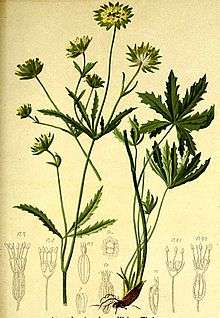Astrantia minor
Astrantia minor, the lesser masterwort,[1] is a species of herbaceous plant belonging to the family of Apiaceae.
| Astrantia minor | |
|---|---|
 | |
| Scientific classification | |
| Kingdom: | |
| (unranked): | |
| (unranked): | |
| (unranked): | |
| Order: | |
| Family: | |
| Genus: | |
| Species: | A. minor |
| Binomial name | |
| Astrantia minor | |
Description
Astrantia minor is a flowering plant that often reaches 15–30 cm in height, with simple stems, rarely branched in the upper half, the basal leaves are of two types, often on the same plant: one with narrow segments that are all pinnatisect, the other with broad segments, the central being pinnatisect and the lateral being deeply pinnatipartite; petioles 4–12 cm; the leaf blade with (5) 7 (8) segments of 1-3 (4.5) x 0.5 -1.3 cm, pale green, toothed in upper half or two thirds, the stem at the base of the inflorescence, from 2 to 3.2 x 0.2-0.5 cm reduced to 3-5 segments. Inflorescence with 1-3 peduncles unequal, the central, sometimes branched, and longer than the sides that have unique umbels; Umbels surrounded by (10) 12-14 bracts, 4-10 x 1–3 mm, membranous, entire, the apex green with three ribs. The flowers are 30-40 per umbel, of the same length or slightly shorter than the bracts, generally hermaphroditic in the centre and male peripherally. Calices have teeth about 1 mm in size, ovate-oblong, subobtuse and slightly bearded (1.5-2 times longer than wide). Petals are similar in size to the sepals and white or cream. Stamens exserted. Fruit ovoid (1.5) 2–5 mm with scales in the form of a vesicle, subobtuse.
It differs from its congener Astrantia major, by its smaller size, and basal leaves of seven segments (instead of five) with calyx teeth that are obtuse and slightly mucronate.
Habitat
Found in some clumps of large plants near streams and in clearings in the scrubland of mountain azalea (Rhododendron ferrugineum), on fresh alpine and subalpine soil. It prefers a pure silicaceous substrate, at elevations of (1850) 2100 - 2300 (2600) meters. Flowering occurs from July to August and fruiting in August–September.
Distribution
Endemic to central and southern Europe (France, Switzerland, Italy and Spain). In the Iberian Peninsula it is found only in the Pyrenees, the Catalan lands and Huesca where it is found in the extreme southwest Valle de Benasque.
Taxonomy
Synonyms:
- Astrantia alpina Clairv. [1811, Man. Herbor. : 78]
- Astrantia major subsp. minor (L.) Bonnier & Layens [1894, Fl. Fr. : 135]
- Astrantia helleborifolia Salisb. [1796, Prodr. : 159] [nom. illeg.]
- Astrantia digitata Moench[2][3][4]
References
| Wikispecies has information related to Astrantia minor |
| Wikimedia Commons has media related to Astrantia minor. |
- "BSBI List 2007". Botanical Society of Britain and Ireland. Archived from the original (xls) on 2015-01-25. Retrieved 2014-10-17.
- Tela Botánica: Astrantia minor Archived September 29, 2011, at the Wayback Machine
- Real Jardín Botánico: Proyecto Anthos - Astrantia minor
- Astrantia minor - Herbario Virtual del Mediterráneo Occidental